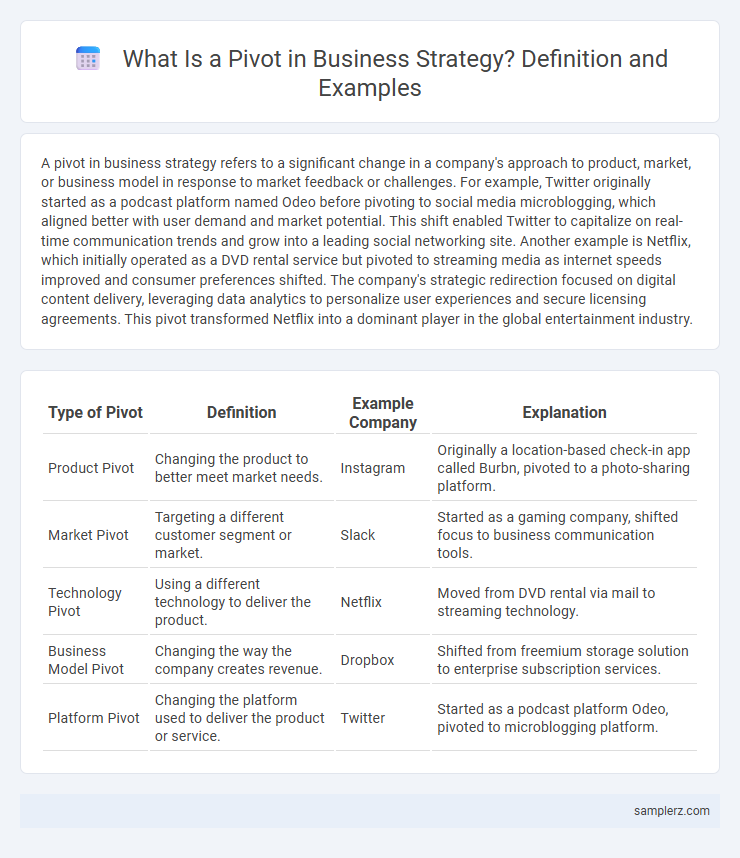A pivot in business strategy refers to a significant change in a company's approach to product, market, or business model in response to market feedback or challenges. For example, Twitter originally started as a podcast platform named Odeo before pivoting to social media microblogging, which aligned better with user demand and market potential. This shift enabled Twitter to capitalize on real-time communication trends and grow into a leading social networking site. Another example is Netflix, which initially operated as a DVD rental service but pivoted to streaming media as internet speeds improved and consumer preferences shifted. The company's strategic redirection focused on digital content delivery, leveraging data analytics to personalize user experiences and secure licensing agreements. This pivot transformed Netflix into a dominant player in the global entertainment industry.
Table of Comparison
| Type of Pivot | Definition | Example Company | Explanation |
|---|---|---|---|
| Product Pivot | Changing the product to better meet market needs. | Originally a location-based check-in app called Burbn, pivoted to a photo-sharing platform. | |
| Market Pivot | Targeting a different customer segment or market. | Slack | Started as a gaming company, shifted focus to business communication tools. |
| Technology Pivot | Using a different technology to deliver the product. | Netflix | Moved from DVD rental via mail to streaming technology. |
| Business Model Pivot | Changing the way the company creates revenue. | Dropbox | Shifted from freemium storage solution to enterprise subscription services. |
| Platform Pivot | Changing the platform used to deliver the product or service. | Started as a podcast platform Odeo, pivoted to microblogging platform. |
Understanding Strategic Pivots in Business
A strategic pivot in business involves shifting a company's focus to address market changes or customer needs more effectively, such as Netflix transitioning from DVD rentals to streaming services. This pivot allowed Netflix to capitalize on emerging technology trends and consumer preferences, driving rapid growth and industry leadership. Understanding strategic pivots enables businesses to adapt agility, sustain competitiveness, and unlock new revenue streams in dynamic markets.
Classic Case: Netflix’s Shift from DVDs to Streaming
Netflix's strategic pivot from DVD rentals to streaming services revolutionized the entertainment industry, capitalizing on emerging digital technologies and changing consumer preferences. By investing heavily in content licensing and original productions, Netflix transitioned from a physical distribution model to a scalable, on-demand platform that rapidly expanded its global subscriber base. This shift not only enhanced operational efficiency but also positioned Netflix as a dominant player in the competitive streaming market.
From Hardware to Services: Apple’s Transformation
Apple's strategic pivot from hardware to services exemplifies a successful business transformation. The company shifted focus by expanding its services portfolio, including Apple Music, iCloud, and the App Store, generating recurring revenue streams. This move reduced dependency on iPhone sales while increasing customer lifetime value and market resilience.
Starbucks: Reinventing Customer Experience
Starbucks pivoted its strategy by integrating digital innovation, launching its mobile ordering app to streamline customer experiences and reduce wait times. The company emphasized personalized marketing through data analytics, enhancing customer engagement and loyalty. This strategic pivot not only increased sales but also strengthened Starbucks' competitive advantage in the coffee retail industry.
Twitter’s Origin: Podcast to Microblogging Pivot
Twitter's origin showcases a strategic pivot from its initial concept as a podcast platform to a microblogging service, emphasizing short, real-time updates. This shift capitalized on emerging trends in social media consumption, prioritizing concise communication and user engagement through tweets limited to 140 characters. The pivot transformed Twitter into a leading social networking site, influencing digital communication strategies and real-time news dissemination worldwide.
Slack’s Journey: From Gaming to Team Collaboration
Slack's strategic pivot from a gaming company to a leading team collaboration platform exemplifies effective business adaptation. Originally developed as an internal communication tool for their gaming startup, the founders recognized the broader market demand for seamless workplace messaging and collaboration. This shift enabled Slack to capitalize on the growing remote work trend, transforming it into a billion-dollar enterprise with millions of active users globally.
Instagram: Pivoting to Focus on Photo Sharing
Instagram exemplified a strategic pivot by shifting from a check-in app called Burbn to a dedicated photo-sharing platform, capitalizing on the growing popularity of mobile photography. This pivot allowed Instagram to streamline its features, enhance user engagement through filters and instant sharing, and attract a broader audience. The successful pivot ultimately positioned Instagram as a leading social media app centered around visual content and user experience.
Nokia’s Attempted Pivot to Digital Services
Nokia's attempted pivot to digital services in the early 2010s exemplifies a strategic shift from hardware manufacturing to software and telecommunications solutions. The company aimed to capitalize on the growing demand for mobile internet and digital content by investing in platforms like OVI and collaborating with Microsoft on Windows Phone. Despite strategic intent, limited market traction and strong competition hindered Nokia's success in fully transforming its business model.
LEGO’s Rebound Through Product Innovation
LEGO's strategic pivot centered on product innovation by expanding its product lines to include themed sets such as licensed franchises like Star Wars and Harry Potter, driving significant revenue growth. The company also embraced digital integration through interactive play experiences and mobile apps, enhancing customer engagement. This pivot allowed LEGO to rebound from financial struggles by aligning its offerings with market trends and consumer preferences.
Blockbuster: Lessons from a Missed Pivot
Blockbuster's failure to pivot from traditional DVD rentals to digital streaming highlights critical strategic errors in adapting to market shifts. Netflix's early adoption of online streaming rapidly captured market share, rendering Blockbuster's physical store model obsolete. This missed pivot underscores the importance of agile business strategy and early technology adoption in sustaining competitive advantage.

example of pivot in strategy Infographic
 samplerz.com
samplerz.com